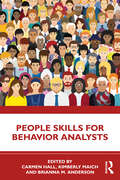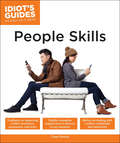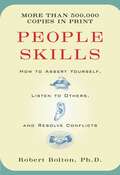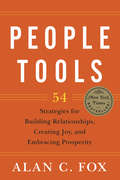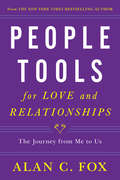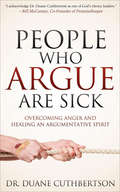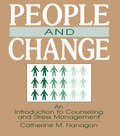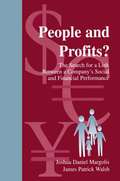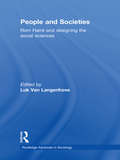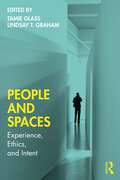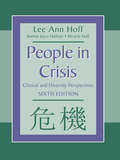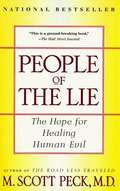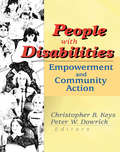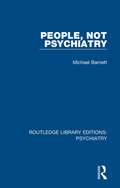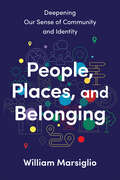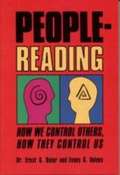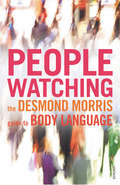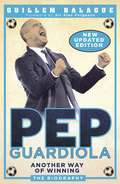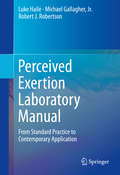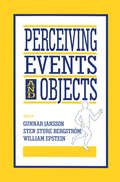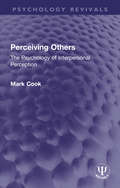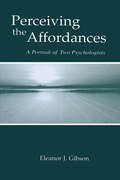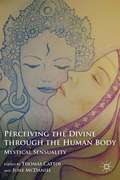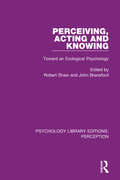- Table View
- List View
People Skills for Behavior Analysts
by Kimberly Maich Carmen Hall Brianna M. AndersonPeople Skills for Behavior Analysts provides a much-needed introduction to the people skills needed to succeed as a behavior analyst. Divided into two primary parts – Foundational Skills and Specialized Skills – this book addresses an impressive breadth of people skills, focusing on intrapersonal and interpersonal skills, collaboration, consultation and training, leadership, and resource development. Relying on recent evidence-based practices and relevant literature tailored to meet the new BACB Task List, Professional & Ethical Compliance Code, and Supervised Independent Fieldwork requirements, the text includes contributions from leading figures from a wide variety of applied behavior analysis subfields to provide a truly balanced overview. The book delves into the literature from fields related to behavior analysis, such as counselling, psychology, graphic design, management and education, and applies these perspectives to behavioral theories and principles to provide students, new graduates, and seasoned professionals with research, best practices, reflective questions, and practical techniques. From reflecting on one’s practice, to learning essential therapeutic skills, running a great meeting, becoming a ‘super’ supervisor, and delivering a memorable presentation, all people skills are included in one place for the behavior practitioner. This is a valuable resource for undergraduate and graduate students studying Applied Behavior Analysis (ABA), and will also appeal to recent graduates and behavior analysts looking to improve their existing skillset.
People Skills: Helpful Guidance on Interacting in Any Situation (Idiot's Guides)
by Casey HawleyPeople skills — also known as interpersonal skills — are key to succeeding in work and in life. Many people struggle with these specific skills, particularly in an increasingly digital world. Idiot's Guides: People Skills offers expert advice on the foundations of effective communication, tips on understanding and maximizing nonverbal communication, ways to handle conflict and difficult conversations, pointers on being more influential and persuasive, and a primer for public speaking to small or large groups.
People Skills: How To Assert Yourself, Listen To Others And Resolve Conflicts
by Robert BoltonA wall of silent resentment shuts you off from someone you love....You listen to an argument in which neither party seems to hear the other....Your mind drifts to other matters when people talk to you.... People Skills is a communication-skills handbook that can help you eliminate these and other communication problems. Author Robert Bolton describes the twelve most common communication barriers, showing how these "roadblocks" damage relationships by increasing defensiveness, aggressiveness, or dependency. He explains how to acquire the ability to listen, assert yourself, resolve conflicts, and work out problems with others. These are skills that will help you communicate calmly, even in stressful emotionally charged situations. People Skills will show you * How to get your needs met using simple assertion techniques * How body language often speaks louder than words * How to use silence as a valuable communication tool * How to de-escalate family disputes, lovers' quarrels, and other heated arguments Both thought-provoking and practical, People Skills is filled with workable ideas that you can use to improve your communication in meaningful ways, every day.
People Tools
by Alan C. FoxGetting along well with others is the real secret to success and happiness. In tens of thousands of classrooms we teach reading, writing, and arithmetic and yet we leave solutions to the universal problems of human relationships to be discovered, if at all, by trial and error. The trial is painful and the error is costly. People Tools: 54 Strategies for Building Relationships, Creating Joy, and Embracing Prosperity, provides time-proven techniques that you can use to build a better, happier, more successful life. It is the perfect resource for busy people looking for fast and effective solutions to the challenges we face every day. "People Tools" are practical and easy to understand. From developing self-confidence, to improving communication skills, to finding constructive ways to resolve conflict, each "People Tool" addresses a specific issue and provides a simple, straightforward strategy that you can adopt to bring about a positive result. Open the book to any page and you will find a useful solution. Each tool is illustrated with insightful stories and amusing anecdotes that are relevant and relatable. The stories will reel you in but the advice will change your life. "This book will do a lot for the world. " - Bill CosbyAlthough you may recognize the more intuitive techniques in People Tools, this sourcebook provides explanations and helpful examples from a vast collection of different tools designed to help you further expand your own existing repertoire of skills. Some of the useful "People Tools" in the book include:1. The Belt Buckle. When words are different than action (The Belt Buckle), trust the Belt Buckle, not the words. 2. Buy a Ticket. To make something good happen in your life you have to participate. 3. Catching a Feather. An alternative to the endless chase, this Tool reveals how to attract people you want to be closer to. 4. Patterns Persist. Prior actions are predictive of future behaviors. 5. Catch Them Being Good. Rewards are more effective than punishments. People Tools is organized into 54 chapters. Each chapter offers a life-changing insight. "Use them to live well, and your life will grow better for it. " -Jack Kornfield, psychologist, author, and founder of Spirit Rock Meditation Center
People Tools for Love and Relationships
by Alan C. FoxLove is the answer and you are the key to unlocking its potential. From the popular New York Times best-selling author of the People Tools series comes People Tools for Love and Relationships. With 49 easy to use tools, Alan Fox's latest installment will teach you how to create and maintain great relationships with immediate results. Finding love isn't always easy. Being in love and sustaining that love can be even harder. Alan Fox is full of practical advice and guidelines for keeping things fresh and celebrating love in all its manifestations. These tools are specifically designed to teach you everything you need to nourish a long and fulfilling relationship. Each tool is fleshed out with colorful anecdotes and Fox's own discerning insights. It's time to take full responsibility for creating and maintaining your ideal relationship. Stop blaming othersâthe key to a great relationship is you. People Tools is packed with the wisdom of a full, long, and varied life. Alan Fox will guide you through the ins and outs of building worthwhile, rewarding relationships. Learn to: · Find the right person, and be the right person · Work out core issues and compromise · Accept the things you can't change · Find the right way to say âI'm sorryâ · Know when to put yourself first · Live without regret
People Who Argue Are Sick: Overcoming Anger and Healing an Argumentative Spirit
by Duane CuthbertsonWe live in a world of anger and violence. National and international tensions surround us. It it possible to discern the source of such wrath? Dr. Cuthbertson will share with you that the “human spirit” can be “crushed” and “fractured.” Both temperament and environmental factors are involved. If you have ever had an argument, "People Who Ague Are Sick" is definitely for you. The author will give to you not only hope, but also a technique for healing. Let’s be bold. . ."People Who Ague Are Sick" has the potential to not only change you and your home, but to change the whole world. Through "People Who Ague Are Sick" you will learn that your argumentative spirit can be healed, you potentially have had your last argument, domestic violence can subside, there can be less violence in the world.
People and Change: An Introduction To Counseling and Stress Management
by Catherine M. FlanaganHow to capitalize on change -- as a key feature of modern living - - is the central theme of this work. Incorporating the major theoretical advances psychology has made during the last thirty years, People and Change describes how clinical levels of psychological difficulty can develop and how problems such as phobias, depression, shyness, marital and sexual disharmony, obsessions, and over-indulgence are treated. Although a psychology text, People and Change offers an unusually broad scope. The text acknowledges the interplay of somatic vulnerabilities, environmental influences, large individual differences, and various other factors that can be involved in the complex stress process that leads to bad habits. The ability of the individual to adapt to change through self-knowledge is stressed throughout this important book.
People and Profits?: The Search for A Link Between A Company's Social and Financial Performance (Organization and Management Series)
by James P. Walsh Joshua Daniel MargolisWhat is the relationship between the social performance of companies and their financial performance? More colloquially, can a firm effectively attend to both people and profits as it conducts its business? This question has been investigated in no fewer than 95 empirical studies published since 1972. The authors have assembled a compendium of this research to give researchers and practitioners alike a broad overview of these 95 studies and a systematic database detailing the content of each one. This book provides a comprehensive portrait of this research literature. It begins with a broad orientation to the literature, exploring why the link between social and financial performance has been subject to continual inquiry and often heated debate. The authors then present an integrated overview of the 95 studies. Through the charts and tables, the authors illuminate the nature of the studies conducted; the data samples selected for investigation; the ways in which financial and social performance have been measured; and the overall tally of results.
People and Societies: Rom Harré and Designing the Social Sciences (Routledge Advances in Sociology)
by Luk Van LangenhoveRom Harré has pushed the boundaries of our thinking about people and societies and has challenged the orthodox philosophy of science and social psychology. His countless books and articles have inspired generations of scholars in philosophy, psychology, linguistics, cognitive science and social theory. The diversity of his work makes that some see him as a leading figure in the critical realist school of philosophy of science, other as a key player in developing a social constructionist approach to psychology. The present volume brings together a careful selection of his key writings and presents them in a framework that stresses the evolution of his thinking as well as the place of his thinking in ongoing debates in different disciplines. The overall theme is the study of people and their ways of life. This is the first book that gives readers a systematic introduction in the conceptual universe of this towering figure.
People and Spaces: Experiences, Ethics, and Intent
by Tamie Glass Lindsay T. GrahamPeople and Spaces: Experience, Ethics, and Intent examines the dynamic relationship between built environments and human behavior in today's rapidly evolving world.Co-edited by a designer and a psychologist, this interdisciplinary collection reveals how the spaces we inhabit shape and reflect our self-expression, social structures and cultural values. Drawing on diverse perspectives, case studies and innovative research, People and Spaces equips readers from any discipline with practical human-centric knowledge to enhance environments in meaningful ways. This blend of essays and expert insights demonstrates the value of intentional approaches to design and research and offers actionable guidance for creating supportive and sustainable environments.This book is relevant to a broad audience, including scholars, professionals, and students in architecture, interior design, psychology, and related fields, as well as industry practitioners interested in the intersection of built environments and human experience. It is an essential resource for those seeking to understand and influence the dynamic relationship between people and space.
People in Crisis: Clinical and Diversity Perspectives
by Lisa Brown Lee Ann Hoff Miracle R. HoffThe first edition of People in Crisis, published in 1978, established success as a comprehensive and user-friendly text for health and social service professionals. The book and its following incarnations included critical life events and life cycle transition challenges, clearly pointing out the interconnections between such events, stressful developmental changes, and their potential for growth but also danger of suicide and/or violence toward others. This revised edition includes new case examples and expanded coverage of cross-cultural content, including 'commonalities and differences' in origins, manifestations, and crisis responses. The authors illustrate the application of crisis concepts, assessment, and intervention strategies across a wide range of health and mental health settings, as well as at home, school, workplace, and in the community. Each chapter contains a closing summary that includes discussion questions, references, and online data sources for maximum application and learning. Updated chapters discuss new, research-based content on: • workplace violence and abuse• youth violence in schools and higher education settings• the use of psychotropic drugs, including for very young children in the absence of comprehensive assessment• the crisis vulnerability of war veterans and the hazards of 'pathologizing' what should be considered a 'normal' response to the repeated and catastrophic trauma of war• the intersection of socio-political factors with individuals’ psychological healing from catastrophic experiences such as war and natural disaster.
People of the Lie: The Hope for Healing Human Evil
by M. Scott Peck<p>In this absorbing and equally inspiring companion volume to his classic trilogy—The Road Less Traveled, Further Along the Road Less Traveled, and The Road Less Traveled and Beyond—Dr. M. Scott Peck brilliantly probes into the essence of human evil. <p>People who are evil attack others instead of facing their own failures. Peck demonstrates the havoc these people of the lie work in the lives of those around them. He presents, from vivid incidents encountered in his psychiatric practice, examples of evil in everyday life. <p>This book is by turns disturbing, fascinating, and altogether impossible to put down as it offers a strikingly original approach to the age-old problem of human evil.</p>
People with Disabilities: Empowerment and Community Action
by Peter W. Dowrick Christopher B. KeysDevelop more effective community initiatives and build solid collaborations!Although the fields of disability studies and community psychology developed separately, with little crossover, they have evolved similar values, principles, and tactics. People with Disabilities: Empowerment and Community Action is the first volume to bring together these two fields. Now disability activists and community psychologists can join forces, share ideas, and gain strength from one another.This landmark volume offers empirical research and practical advice from respected scholars in the field. People with Disabilities: Empowerment and Community Action presents tested strategies for empowering a wide variety of people with disabilities, including Latinos, the aged, the developmentally disabled, low-income schoolchildren, and patients with chronic diseases. The diversity of strategies offered here means that every community can find a way to make its own voice heard.People with Disabilities: Empowerment and Community Action offers detailed, step-by-step plans for developing a broad range of programs, including: choosing strategies to suit rural, suburban, and urban environments taking a capacity-building approach to community empowerment developing participatory action plans building effective coalitions enabling collaboration between inner-city universities and the community With its solid research, helpful tables and figures, and well-organized action plans, this book is certain to become a classic in the fields of disability studies and community psychology.
People, Not Psychiatry (Routledge Library Editions: Psychiatry #2)
by Michael BarnettOriginally published in 1973, this book is about people and psychiatry. About people who rejected psychiatry as it was generally practised at the time, people who sought for and found alternative ways of caring for and healing one another. The author, who had been active in radical alternatives to psychiatry for some time, offers us a programme based not on drugs, repression and a ‘questionable’ expertise, but on human caring, greater awareness of the body, deeper communication between persons and a willingness to let the emotions flow. It is a challenging alternative which came at a time when the viability of scientific, theoretical and chemical approaches to distress were being questioned at all levels of society. This alternative includes the new direct methods of healing (making whole) such as Encounter, Gestalt, Bioenergetics, Psychofantasy – methods that do not do things to people but allow them to feel their way into change through experiment, flow and choice. The main focus of the book is People, not Psychiatry (PNP), the network set up by the author in 1969. PNP is open to all, and people in it help one another in times of stress and crisis, if they are asked to and when they are needed. One of the main assets of these networks is that they are an alternative and they are there. The book tells the story of PNP’s birth and growth. It is a personal story, a moving story, a story about people. In addition, the book contains some lively theoretical discussion, both simple and clear, in the course of which the author tentatively offers his own theory of neurosis – that many people become victims of the primitive logic patterns laid down in infancy, patterns that become reinforced through fear and habit and have to be dissolved or replaced if we are to enjoy a full, healthy, free-flowing life. The book is directed at doctors, patients, consultants, nurses, psychologists, social workers, therapists, in fact anyone involved in any way in the field of psychiatry. It is also offered to all those whom psychiatry touches, that it to say – everyone.
People, Places, and Belonging: Deepening Our Sense of Community and Identity
by William MarsiglioPlace matters – for good and bad. Infinitely diverse in form, place embodies the action settings where social life happens. Often fighting to preserve a sense of group belonging in the process, we design places to reflect our values and interests. With an eye on our rapidly changing world, People, Places, and Belonging explores how social realities at every level are affected by the places we collectively forge across various social domains. The book shows how place-related circumstances can promote personal empowerment, civic engagement, and social and environmental justice. Discussing places that affect personal and social well-being, including homes, communities, vehicles, and the metaverse, William Marsiglio illustrates how a web of social processes involving claims, attachments, rituals, and transitions (CART) structure our experiences in place. The author argues that we can use decision-making principles to enhance our attachments, encourage supportive rituals, smooth out transitions, and manage claims with less conflict and more social justice. Armed with a heightened place consciousness and ethical principles, People, Places, and Belonging ultimately posits that we must individually and collectively build places that enrich our lives, celebrate the communal spirit, and foster social equity and ecological justice.
People-Reading: How We Control Others, How They Control Us
by Ernst G. Beier Evans G. ValensOf the many books designed to help with the understanding of one's behavior, People-Reading is in a class by itself. It provides specific guidelines on how to "read" people as well as how to "read" oneself. It is an easy to read book that is based on sound scientific principles, illustrated with many well-selected cases from Dr. Beier's own work as a psychotherapist.
Peoplemaking
by Virginia SatirAll of the ingredients in a family that count are changeable and correctable - individual self-worth, communication, system, and rules - at any point in time. Any piece of behavior, at a moment in time, is the outcome of the four-way interplay of the person's self-worth and body condition of that moment, his interaction with another, his system, and his place in time and space and situation. To explain his behavior, something needs to be said about all these facts, not just one, and then consider how each part influences the other.
Peoplewatching: The Desmond Morris Guide to Body Language
by Desmond MorrisPeoplewatching is the culmination of a career of watching people - their behaviour and habits, their personalities and their quirks. Desmond Morris shows us how people, consciously and unconsciously, signal their attitudes, desires and innermost feelings with their bodies and actions, often more powerfully than with their words.
Pep Guardiola: Another Way of Winning: The Biography
by Guillem Balague'A must-read for anyone who's doubted Pep's influence, from handing the power to Barça's homegrown crop to never betraying his childhood romanticism of the game Four Four Two'Balague's insightful biography presents Guardiola as a relentless perfectionist - a man obsessed with the minutiae of football, often unable to switch off' SPORTThis fully updated edition of the international bestseller includes Manchester City's incredible 2017-18 league triumphPep Guardiola is the most successful and sought-after football coach in the world. After being appointed first-team manager in 2008, he transformed Barcelona into arguably the greatest club side of all time, winning thirteen trophies in four years, and he won the Double twice in his three years in charge of Bayern Munich. He then faced his biggest challenge yet when he joined Manchester City in 2016: to turn them into a team that consistently wins in the most difficult of leagues and a regular challenger in the Champions League. But in only his second year at the club, he had turned a good side into memorable one, leading them to the Premier League title in record-breaking style . . . and doing it the Guardiola way.Guillem Balagué has followed Pep's career from the outset and has had direct access to the man and his inner circle for this updated edition. This then is the definitive portrait of Pep Guardiola and his relentless pursuit of footballing perfection.
Perceived Exertion Laboratory Manual
by Michael Gallagher Jr. Luke Haile Robert J. Robertson This manual provides laboratory-based learning experiences in perceptually and psychosocially linked exercise assessment, prescription, and programming. The primary pedagogic outcome is the ability to use applied theory and practice in perceptual and psychosocial exercise assessment and program design to promote the adoption and maintenance of a physically active lifestyle, enhancing overall health fitness. Perceptual and psychosocial variables are presented in individual, stand-alone laboratory modules that can supplement existing curricula such as exercise and sport psychology, exercise physiology, exercise testing and prescription, and exercise training and conditioning. In addition, the complete modular set has a conceptual flow that allows its presentation as an entire, laboratory-based course. The laboratory modules are divided into three primary units: assessment (theoretical constructs, scales and procedures, tests), prescription (self-regulation, performance), and program evaluation. The manual uses a unique format in which case studies are embedded in the conceptual flow of each lab module facilitating translation of laboratory results to real-world application. The manual concludes with a discussion of perceptually and psychosocially linked exercise prescription and programming applications in public health, such as program monitoring and adherence.
Perceiving Events and Objects
by William Epstein Gunnar Jansson Sten Sture BergströmBeginning with his doctoral dissertation in 1950 which introduced the study of event perception and the application of vector analysis to perception, Gunnar Johansson has been a seminal figure in the field of perception. His work on biomechanical motion in the 1970s challenged conventional notions and stimulated great interest among experimental psychologists and students of machine vision. In 1989 Johansson published his latest theoretical synthesis, the optic sphere theory, an innovative conceptualization that goes beyond his earlier proposals. This volume presents -- for the first time -- an extensive precis of the out-of-print classic 1950 monograph prepared by Johansson. It also includes a representative set of Johansson's important publications produced over the ensuing four decades. These papers served as the springboard for a set of original essays by a distinguished group of North American and European scientists. Part critical commentary, part elaboration, and part seeking new directions, the entire collection makes for a singularly rich treatment of the perception of objects and events.
Perceiving Others: The Psychology of Interpersonal Perception (Psychology Revivals)
by Mark CookOriginally published in 1979, Perceiving Others is an excellent, short introduction to the area of social psychology known as ‘person perception’, ‘social perception’ or ‘impression formation’ – how people interpret each others’ moods, predict each others’ behaviour and sum up each others’ characters. The way people see each other determines the way they behave towards each other making the study of ‘person perception’ essential to the understanding of social behaviour. Mark Cook poses three questions about how people form opinions of others: what are the processes involved, what information is used and how, and how accurate are they? He provides an answer to these questions in the three main sections of the book, giving a comprehensive survey of the theory and research arising from the issues involved. The topics covered include the meaning of trait descriptions, intuition, social skill and non-verbal communication, the impression formation paradigm, stereotypes, implicit personality theories, attribution theory, Cronbach’s components and psychiatric diagnosis. By drawing many of his illustrations from everyday encounters, the author effectively bridges the gap between theory and reality to create a thoroughly readable and comprehensible study.
Perceiving the Affordances: A Portrait of Two Psychologists
by Eleanor J. GibsonPerceiving the Affordances is a personal history and intellectual autobiography of Eleanor Gibson, the groundbreaking research psychologist who was influential in the founding of the theory of perceptual development. It is also a biography of her husband, James J. Gibson, who was a major perceptual theorist and the founder of the ecologically-oriented theory of perception. This is the story of their lives together and how each came to make particular contributions. This book is of interest to people who study perception, perceptual development, infancy, developmental psychology, and the history of psychology.
Perceiving the Divine through the Human Body
by Thomas Cattoi June McdanielCattoi and McDaniel present a selection of articles on the role of the body and the spiritual senses - our transfigured channels of sensory perceptions - in the context of spiritual practice. The volume investigates this theme across a variety of different religious traditions within Christianity, Hinduism, Buddhism, and Daoism.
Perceiving, Acting and Knowing: Toward an Ecological Psychology (Psychology Library Editions: Perception #27)
by Robert Shaw and John BransfordOriginally published in 1977, the chapters in this volume derive from a conference on Perceiving, Acting and Knowing held by the Center for Research in Human Learning at the University of Minnesota in 1973. The volume was intended to appeal, not just to the specialist or the novice, but to anyone sufficiently interested in psychology to have obtained a sense of its history at the time. Through these essays the authors express a collective attitude that a careful scrutiny of the fundamental tenets of contemporary psychology may be needed. In some essays specific faults in the foundations of an area are discussed, and suggestions are made for remedying them. In other essays the authors flirt with more radical solutions, namely, beginning from new foundations altogether. Although the authors do not present a monolithic viewpoint, a careful reading of all their essays under one cover reveals a glimpse of a new framework by which theory and research may be guided.
